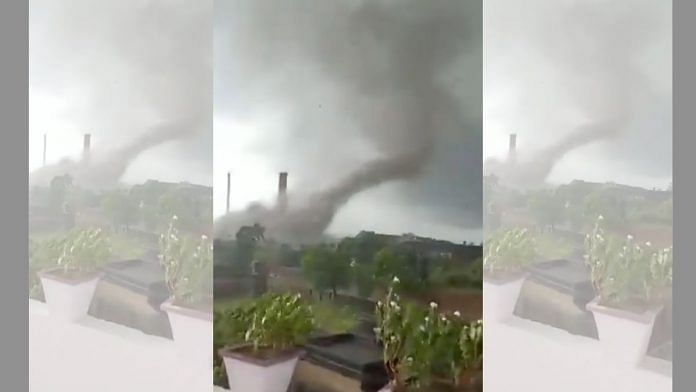Bengaluru: A tornado hit West Bengal’s Hooghly district ahead of Cyclone Yaas Tuesday. Visuals captured by onlookers shows the clear swirling column of air carrying dust and debris.
The weather phenomenon occurred in the North 24-Parganas and parts of Hooghly district, lasting for a minute and half. According to reports, it destroyed about 40 houses.
Tornadoes are rotating columns of air that have contact with the Earth on one end and storm clouds on the other. While tornadoes are not common in the Indian subcontinent, they are not unheard of, and the Bengal region is especially prone to it.
Also read: What Cyclone Tauktae tells us about Arabian Sea & why the coast is seeing more severe cyclones
How tornadoes are formed
Tornadoes, also called twisters in North America, typically appear in the form of funnel clouds extending from the surface to the clouds with violently rotating winds carrying dust, debris and material in the air. These winds move at speeds greater than 64 kmph.
Most tornadoes are narrow columns of wind, widening at the top. They can also be very loud up close, sounding like a combination of a jet engine, a train, waterfalls and more. Tornadoes also tend to reduce cloud-to-ground lighting in the area when they extend from the cloud and ground.
Tornadoes can often precede or succeed a storm, feeding off on the warm, moist air around the storm. The thunderstorm structure that houses the rotating updraft of wind, which can produce other phenomena like hail, is called a supercell. Supercells form separate from other thunderstorms and gather strength over a wide area.
When there is a lack of moisture, a fully formed tornado might not display its typical funnel cloud or visible rotating winds shaped like a cone.
Just like with a cyclone, the centre of a tornado is called the eye. It is a circular area, several kilometres wide, of mostly calm weather with mellow winds and clear skies. The eye is surrounded by the ‘eyewall’, where the most severe and strongest winds and storms of the tornado occur.
Till date, only two people have claimed to be in the eye of a tornado. Both were farmers from the US, where three out of four tornadoes in the world occur.
Tornadoes are powered and grow until their peak as long as there is an inflow of warm moist air. Once it reaches its peak or mature stage, the winds that accelerate towards the ground start to wrap around the tornado with cool winds, cutting of the inflow and leading to the tornado’s dissipation.
Tornadoes in Bengal
Tornadoes grow quickly on vast plains although they occur on various kinds of terrain. New research shows that tornadoes likely form by winds closer to the ground than to the clouds.
Winds in the mid-upper troposphere split around the Tibetan Plateau, allowing westerlies to be stronger in the Bengal region. The Bay of Bengal is also constantly dumped with freshwater from rivers like Ganga and Brahmaputra, which then are warmed up by the heat and evaporate as humidity, creating a ready source to feed warm moist air to any storm.
Tornadoes have historically occurred in the Bay of Bengal region; they are most likely to occur in the late afternoons during the pre-monsoon months of March to May in Northeast India or Bangladesh. The first documented tornado in the region occurred near Calcutta on 8 April 1838.
Between the years of 1838 and 2001, a total of 86 tornadoes occurred in the Bengal region. By contrast, northwest India and Pakistan have seen only 15 tornadoes between the years 1903 and 2012.
(Edited by Manasa Mohan)
Also read: More floods, severe heatwaves: Govt predicts climate change impact on India this century



